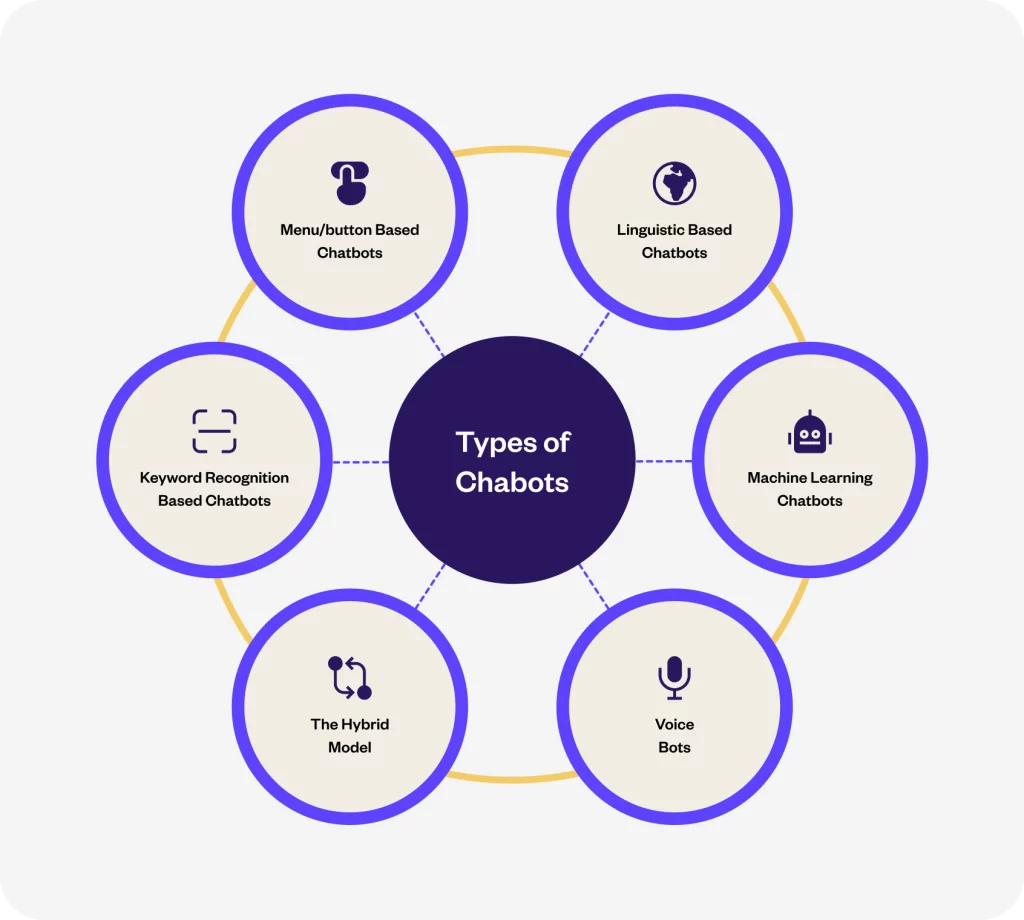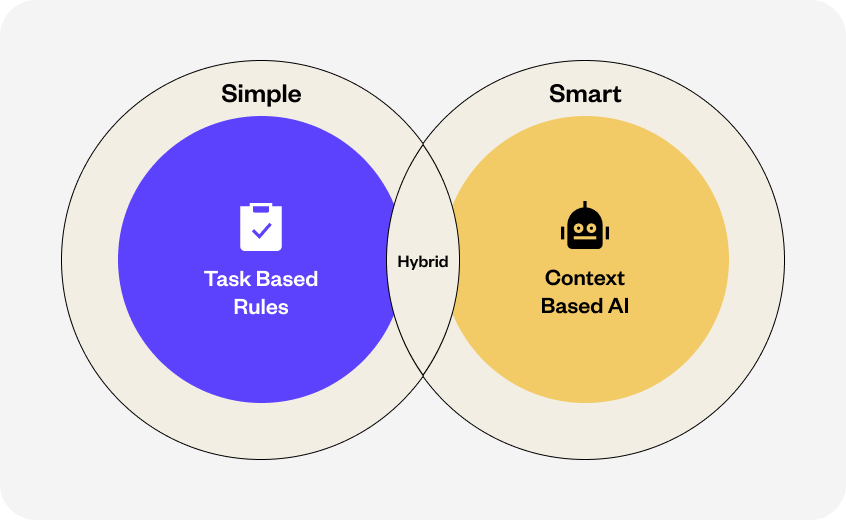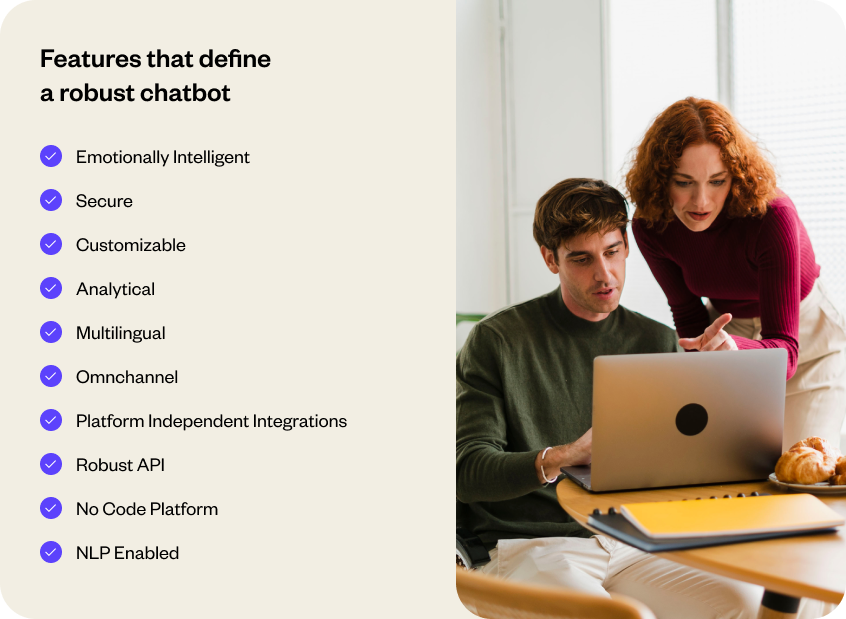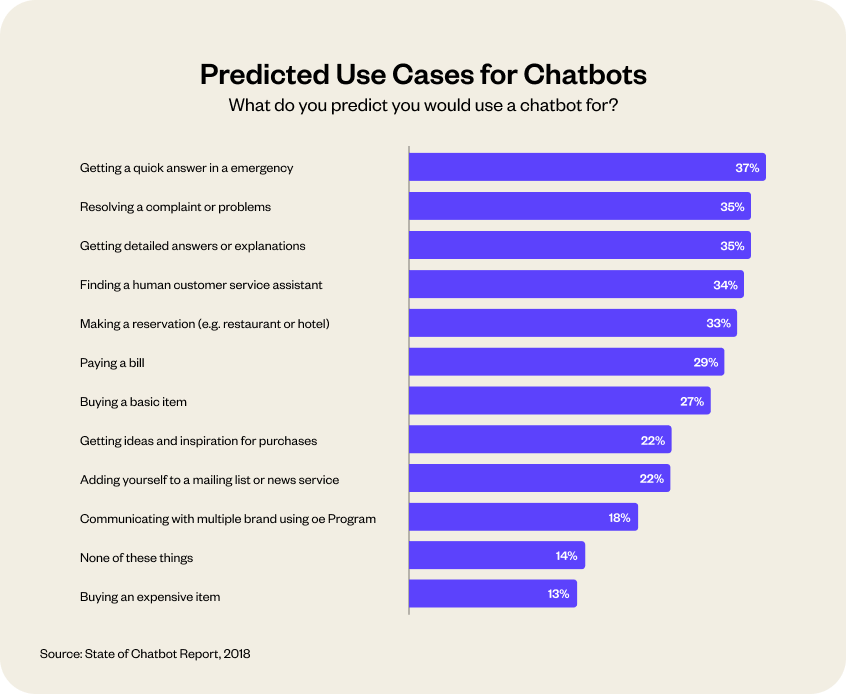Customer expectations are ever-evolving, and the strategic deployment of diverse chatbot types becomes crucial for staying ahead of your competition. This guide contains all the to decode various types of chatbots and their functionalities. Furthermore, we also delve into the strengths and ideal use cases of different types of chatbots to equip businesses to identify the perfect chatbot alignment for their unique needs. With a spectrum ranging from simple, rule-based bots to advanced, AI-driven conversational agents, this article goes beyond the binary, offering insights to help you glean the optimal benefits from your chatbot investment.
Chatbots are as diverse as they are intriguing. As business leaders, you’ve already tapped into the potential of chatbots. However, understanding the full spectrum of chatbot types can be a differentiator in fine-tuning your customer interactions.
Related must-reads:
- AI chatbots – The complete guide to chatbot solution
- How to create a chatbot – Best practices to follow in 2023
- 9 Best chatbot examples for businesses by industry [2023]
- Enterprise Chatbot – A Guide for Enterprises [2023]
- Benefits of AI Chatbots for Businesses and Customers
What is a chatbot?
Simply put, a chatbot is a sophisticated piece of software designed to engage users in conversation. While it might feel like you’re having a chat with another human, it’s all thanks to the digital prowess of these bots. Some chatbots stick to the script, offering predefined answers to common questions. Yet, there’s more to chatbots than these basic models. Venture a bit further, and you’ll meet advanced digital assistants equipped with the ability to learn, adapt, and provide tailor-made responses, all by analyzing rich data streams.
What are the different types of chatbot?

When looking at the vast arena of business technology, chatbots emerge as versatile players, each with a unique strategy. To lead the game, understanding these strategies can be your ace card.
1. Rule-based chatbots
These are akin to the foundational building blocks of a corporate strategy—consistent and reliable. For instance, many businesses deploy them for preliminary lead generation, offering predefined responses. Yellow.ai integrates this model efficiently, ensuring swift customer interactions.
2. Keyword recognition-based chatbots
Imagine a meticulous analyst who identifies patterns and trends. These chatbots pick out crucial keywords from a conversation and offer more nuanced responses, reminiscent of how Yellow.ai’s chatbots process user inputs to generate contextually relevant replies.
3. Menu-based chatbots
Just like an ATM machine guiding you through options, these chatbots simplify user journeys with preset menus. They’re especially valuable in e-commerce settings, guiding users from product queries to checkout.
4. Contextual chatbots (Intelligent chatbots)
These are the strategic consultants of the chatbot world. With an understanding of past interactions, these chatbots remember your preferences, much like Yellow.ai’s platform that harnesses AI to deliver personalized experiences, making user interactions genuine and timely. Equipped with NLP and machine learning, these are best for businesses eyeing in-depth customer engagement.
5. Hybrid chatbots
Consider them your integrated business suites, combining the strengths of various models. Yellow.ai’s platform showcases this versatility, accommodating both structured and AI-driven interactions.

6. Voice-enabled chatbots
These are the trendsetters. They echo the rise of voice-activated tools in boardrooms and executive suites. Their voice recognition technology caters to high-level multitaskers, offering hands-free interactions.
Now, if you were to view chatbots through the lens of conversation style, we’d primarily have:
Declarative chatbots
Think of them as your digital front desk—efficient, scripted, and handling standard queries. They anchor the frontline, addressing FAQs and managing routine tasks.
Predictive chatbots
The C-suite’s digital ally. Like a seasoned business strategist, they’re equipped with advanced tools—NLU, NLP, and AI/ML. Whether it’s Alexa presenting market trends or Siri scheduling executive meetings, they’re all about personalization and precision.
Rule-based chatbots vs. AI chatbots
Two primary contenders stand out when considering the chatbot spectrum: the steadfast Rule-based chatbots and the dynamic AI chatbots. It’s akin to choosing between a reliable classic car or a cutting-edge electric vehicle. Each has its merits, but the key lies in understanding their capabilities to suit your business terrain. Let’s comparatively dissect their features.
| Aspect | Rule-based Chatbots | AI Chatbots |
| Learning ability | Static: Cannot learn from user interactions. | Dynamic: Continuously learns and improves from user interactions. |
| Response flexibility | Limited: Can only respond to predefined queries. | Versatile: Can understand and respond to a wide range of user inputs, even if they haven’t been pre-programmed. |
| Conversational flow | Rigid: Follows a linear conversation flow. | Natural: Mimics human conversation, allowing for a more fluid and organic interaction. |
| Complexity of queries | Basic: Can handle simple, straightforward queries. | Advanced: Can handle complex queries, context switches, and multi-turn conversations. |
| Integration capabilities | Basic: Limited to certain pre-defined integrations. | Extensive: Can be integrated with a plethora of tools, databases, and other advanced systems. |
| Scalability | Limited: Requires manual intervention to update or scale. | Automated: Can easily scale and evolve as business grows and needs change. |
| User experience | Predictable: Offers the same interaction repeatedly. | Personalized: Offers tailored interactions based on user behavior and preferences. |
| Maintenance | Frequent: Requires regular manual updates to cater to new queries. | Minimal: Self-improves over time, reducing the need for frequent manual updates. |
| Cost over time | Higher: Regular manual updates can increase costs over time. | Cost-effective: The initial setup might be higher rule-based alternatives, but they reduce long-term costs due to self-improvement and scalability.Not just this, they also significantly boost revenue through their advanced personalized up-selling and cross-selling abilities. |
To ascertain the right fit for your company, some pivotal questions arise:
- What’s the nature of your business?
- What objectives does your firm aim to achieve with the chatbot?
- Do you have the resources for bot development and implementation?
- What’s the intricacy and frequency of user interactions and ensuing queries?
From a bird’s-eye business view, AI chatbots undoubtedly present an alluring promise. Their ability to connect the dots between past and current user interactions allows for seamless, personalized interactions. While rule-based chatbots are the tried-and-true workhorses, an adeptly trained AI bot can surpass them in multi-dimensional query resolutions, becoming sharper each day.
The business value of different types of AI chatbots
As we delve deeper into the AI chatbot spectrum, it becomes paramount to understand their value proposition from a business perspective. Not all AI chatbots are created equal, and their utility can vary significantly depending on their functionality. To put things into perspective, let’s unravel the business value of different types of AI chatbots through a detailed table:
| Features | Informational (4%) | Personalized (42.5%) | Transactional (42.5%) | Intelligent | Conversational |
| Handle simple requests | ✓ | ✓ | ✓ | ✓ | ✓ |
| Process natural language (NLP) | ✓ | ✓ | ✓ | ✓ | ✓ |
| Give personalized answers | ✓ | ✓ | ✓ | ✓ | |
| Confirms user intent | ✓ | ✓ | ✓ | ✓ | |
| Executes transactions on behalf of customers | ✓ | ✓ | ✓ | ||
| Proposes and closes NBA and NBO | ✓ | ✓ | |||
| Keeps conversation natural and forms sentences | ✓ |
The table encapsulates a comparative exploration of AI chatbots based on their capabilities. For instance, while an “Informational” chatbot primarily focuses on processing natural language and handling rudimentary requests, a “Conversational” chatbot goes several steps further. It manages advanced tasks like proposing and closing Next Best Actions (NBA) and Next Best Offers (NBO) and excels in keeping the conversation natural and spontaneous.
Drawing from industry insights, it’s evident that an elementary bot, despite its prowess in NLP and managing basic requests, might not be the top contender in terms of business value. In stark contrast, as the functionalities become more intricate and advanced, such as with Intelligent and Conversational bots, their contribution to business value escalates substantially.
But remember, while these percentages give a bird’s-eye view, the real-world implications can vary. The best AI chatbot for businesses hinges on specific objectives, customer interaction patterns, and the depth of personalization and automation a business seeks.
How to choose the best chatbots for your business?
Understanding AI chatbots’ diverse types and capabilities is just the tip of the iceberg. The subsequent phase involves making an enlightened decision in choosing the most fitting chatbot for your enterprise. Let’s explore a comprehensive evaluation, which is pivotal to identifying and implementing the ultimate chatbot solution for your business.

Here’s a guide through crucial factors to consider, ensuring that your chatbot aligns with your business objectives and also amplifies your customer engagement strategy:
1. Purpose and capabilities: Begin by crystalizing the specific roles and functionalities that you envisage your chatbot performing, ensuring it serves your operational and customer service objectives effectively.
2. Ease of integration: Pursue a chatbot that assures effortless integration with your prevailing systems, making partners like yellow.ai, who specialize in seamless deployments, an invaluable asset.
3. AI and Machine Learning: Probe into the chatbot’s AI and ML capabilities, ensuring it possesses the prowess to evolve and facilitate through continual learning and data processing.
4. Natural Language Processing (NLP): Seek NLP functionalities that empower the chatbot to comprehend and retort to natural language inputs astutely and contextually.
5. Multilingual support: Especially pivotal for global operations, elect chatbots that support diverse languages, ensuring your customer communications are unhindered by linguistic barriers.
6. Customizability: Opt for chatbots that allow you to tailor experiences, enabling the reflection of your brand’s persona and meeting bespoke customer requirements.
7. Scalability: Ensure your chosen chatbot can seamlessly scale, accommodating growth and handling augmented workloads as your business and customer base burgeon.
8. Security and compliance: Steer towards chatbots that adhere rigorously to industry-specific security protocols and regulatory compliance, safeguarding data and interactions.
9. Analytics and reporting: A chatbot with robust analytical and reporting faculties will enable you to track performance meticulously and extract pivotal customer interaction insights.
10. Cost: Analyze the financial implications holistically, including the initial setup, ongoing sustenance, and any pertinent subscription or usage fees.
11. Vendor reputation and support: Choose esteemed vendors like Yellow.ai, who bring a proven track record and excellent customer support, ensuring your chatbot solution is always in proficient hands.
12. User experience: Navigate towards chatbots that guarantee an intuitive, user-friendly experience, ensuring smooth and satisfying customer interactions.
13. Trial periods: Leverage trial periods where possible, permitting you to gauge the chatbot’s compatibility and efficacy with your business needs prior to a full commitment.
Armed with this thorough examination of pivotal factors, your journey toward selecting a chatbot that aligns and enhances your business operations and customer engagement strategy becomes significantly more navigable and assured.
Define the applications of your chatbots: Understanding key applications of chatbots

It is fascinating to see how AI chatbots have genuinely become the unsung heroes of many business operations. From that friendly digital assistant helping you on a website to the prompt HR bot answering your leave-related queries, chatbots have ventured far beyond just the “Hi! How can I assist you today?” Let’s dive deeper into some of these areas:
1. Customer support
- Chatbots, like the friendly ones powered by Yellow.ai, are always awake, ensuring your customers aren’t left hanging, regardless of the time zone.
- They’re snappy, reducing those annoyingly long wait times, and who doesn’t love instant solutions?
- Picture this: Spotify using a chatbot to help users with playlist issues or guiding them to the right music based on their mood. Handy, right?
2. Marketing and sales support
- Think of chatbots as the ever-enthusiastic salesperson who doesn’t take a lunch break. They’re there, initiating conversations, perhaps even throwing in a discount code or two to make a visitor’s day.
- For instance, imagine a chatbot on an online bookstore recommending novels based on a user’s past reads or trending bestsellers.
3. Customer analytics
- Chatbots are beyond just chat machines; they’re insight gatherers. Every interaction, every query, helps paint a clearer picture of customer preferences.
- Consider e-commerce giants using these insights to tweak their sales strategies or even introduce new product lines. It’s a data-driven world out there!
4. HR automation
- Ever thought a chatbot could help with onboarding? With platforms like Yellow.ai, that’s very much a reality. From guiding a newbie through initial setup processes to answering policy-related queries, they’ve got HR’s back.
- It’s a bit like having an HR assistant at your disposal, always ready to help. Imagine a new recruit getting real-time help on benefits enrollment or understanding company culture.
5. ITSM automation (IT service management)
- Imagine if every minor IT hiccup needed a human intervention? Thankfully, chatbots swoop in, automating tasks like ticket creation or even aiding with those frequent “Forgot Password” moments.
- An example that springs to mind is how some global corporations utilize bots to guide remote workers through VPN setups. A true life-saver for the IT department!
When you stitch all these pieces together, it’s clear that chatbots, especially sophisticated ones developed by platforms like Yellow.ai, are far ahead of being just digital talkers. They’re game-changers, shaping the future of business interactions and enhancing operational efficiency.
How to build an AI chatbot with Yellow.ai?
Commencing on the journey to create an intelligent, AI-powered chatbot is a strategic stride towards enhancing customer interaction and experience. Yellow.ai, a platform renowned for its robust capabilities and dynamic features, simplifies and empowers this journey.
Related read: How to create a chatbot – Best practices to follow in 2023
Here’s a comprehensive guide on how to construct your AI chatbot with Yellow.ai, ensuring it is well-equipped to deliver exceptional service.
1. Embrace the Yellow.ai advantage
Initiate your chatbot creation journey with Yellow.ai’s flagship offerings:
- Dynamic Automation Platform (DAP): An enterprise-grade conversational AI platform that sets the foundation for your chatbot.
- No-code Builder: Simplify the construction of your chatbot without diving deep into coding, ensuring a swift and efficient creation process.
- Dynamic NLP: With an astounding 97% intent accuracy, your chatbot will be well-equipped to understand and engage users right from its first interaction.
2. Clearly define your objectives
What do you want your chatbot to achieve? Whether enhancing customer support, streamlining lead generation, or bolstering HR operations, having a clear roadmap from the outset is pivotal.
3. Design engaging conversational flows
With the No-code Builder, craft user-centric conversational pathways. Prioritize user needs and desires, ensuring every interaction is meaningful and impactful.
4. Seamlessly integrate essential data sources
Yellow.ai boasts over 100+ out-of-the-box integrations. Your chatbot can seamlessly link with pertinent data reservoirs and systems, ensuring accurate and up-to-the-minute responses. To add to it, you would not even require making changes to your current tech infrastructure, as Yellow.ai chatbots can be integrated seamlessly into your existing infrastructure.
5. Rigorous training and testing
A chatbot is only as good as its training data. With Dynamic NLP, fine-tune your chatbot to recognize many user queries, ensuring precision in every interaction.
6. Launch across multiple platforms
Once your chatbot is ready, it’s time to introduce it to the world. Whether it’s your official website, popular messaging apps, or social media platforms, Yellow.ai ensures seamless deployment.
7. Dive deep with analytics
With Yellow.ai’s powerful Analytics, gain insights into user interactions and understand their preferences and pain points. This data-driven approach allows for continual optimization, ensuring your chatbot remains a step ahead.
8. Unparalleled user experience
User experience is paramount for any business. Ensure that every interaction with your chatbot is seamless, intuitive, and exceeds user expectations.
So, ready to transform your digital interactions?
Witness the revolution in chatbot technology firsthand

Concluding thoughts: Embracing the future of digital engagement
Steering into the digital age, integrating chatbots into your business model is now a necessity. Harnessing the prowess of platforms like Yellow.ai empowers businesses to craft impactful customer journeys that drive ROI. Remember, a successful chatbot initiative isn’t a mere expenditure; it’s an investment towards an efficient, ROI-driven future. Forge a dynamic partnership with your platform provider, and the horizon of digital excellence awaits.
Frequently asked questions (FAQs)
What are the different types of chatbots?
There are various types of chatbots, including rule-based, AI-powered, hybrid, predictive AI, conversational AI, and voice bots. Each serves distinct purposes based on the user’s needs and the application’s complexity.
What is a rule-based chatbot?
A rule-based chatbot operates based on a predefined set of rules and can only respond to specific commands it has been programmed for.
What is an AI-powered chatbot, and how is it different from rule-based chatbots?
AI-powered chatbots are more like conversational partners. They use artificial intelligence, especially NLP, to interpret and respond to user queries in a more flexible manner. Unlike rule-based bots, which stick to a script, AI chatbots can evolve and adapt based on interactions.
What are hybrid chatbots?
Hybrid chatbots combine the functionalities of rule-based and AI-powered chatbots, providing structured responses while also having the flexibility to handle diverse queries.
How does a predictive AI chatbot work?
A predictive AI chatbot analyzes past interactions and user data to predict and proactively offer solutions or information a user might request.
How does a conversational AI bot differ from other types of chatbots?
Conversational AI bots specialize in simulating human-like conversations, ensuring a more natural, intuitive user experience than other chatbots.
What is a voice bot, and how is it different from a text-based chatbot?
As the name suggests, voice bots are all about audible interactions. Users speak to them, and they respond vocally. In contrast, text-based chatbots rely on written communication, where users type their queries and read the bot’s responses.






















